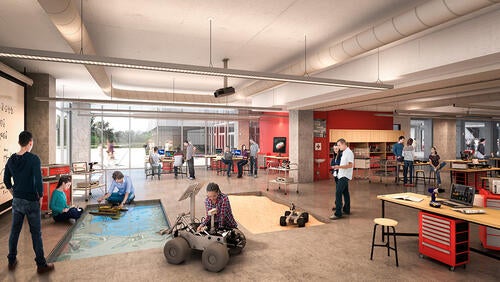
Breaking ground on Waterloo’s $88M Engineering 7 building
The innovative facility will inspire entrepreneurs and support the next wave of high-impact research

The innovative facility will inspire entrepreneurs and support the next wave of high-impact research
By Staff Faculty of Engineering
The University of Waterloo broke ground this week on Engineering 7, an $88-million building that will feature some of the best engineering research and teaching facilities in the world.
The ground-breaking event took place on Thursday November 12, at 1:30 pm at Engineering 5 on the University’s east campus.
The new Engineering 7 (E7) facility will feature an additive manufacturing—or 3D printing—laboratory and an indoor flight arena for testing autonomous and robotic vehicles.
It will also accommodate growth from Waterloo’s new biomedical engineering program and the expansion of the Faculty of Engineering’s highly popular mechatronics engineering program. It will house the Faculty’s new teaching innovation, the multidisciplinary Engineering Ideas Clinic™, where undergraduate students will integrate classroom theory with hands-on learning as they design, build, test and refine ideas.
Part of the funding for E7 will come from the Educating the Engineer of the Future campaign, a $70-million fundraising effort that will help the Faculty of Engineering achieve its goal to become a world-class engineering school.
Earlier this week, GM Canada announced $1 million in funding to support the Educating the Engineer of the Future campaign. This support will fund a Research Chair in advanced materials while also sponsoring Waterloo Engineering’s Capstone Design projects involving software development, which is key to GM Canada’s work on “the connected car.”
E7 will also become the new home for the Conrad Business, Entrepreneurship and Technology Centre. It will have dedicated study and social spaces for students, lecture halls and entrepreneurial support areas, along with areas for student teams to prototype their Capstone Design projects.
Thursday’s groundbreaking event included remarks by Feridun Hamdullahpur, president and vice-chancellor of Waterloo; Pearl Sullivan, dean of engineering and Doug Wright, former president and vice-chancellor of Waterloo and founding dean of engineering.

Read more
New building will house research on machine intelligence, mobile robotics, autonomous vehicles and wearable biomedical devices

Read more
Special issue of Waterloo Magazine celebrates women who lead, and explores equity in education and the workplace

Read more
The Engineering Ideas Clinic™ and an indoor flight testing centre are just part of the Educating the Engineer of the Future campaign
Read
Engineering stories
Visit
Waterloo Engineering home
Contact
Waterloo Engineering
The University of Waterloo acknowledges that much of our work takes place on the traditional territory of the Neutral, Anishinaabeg, and Haudenosaunee peoples. Our main campus is situated on the Haldimand Tract, the land granted to the Six Nations that includes six miles on each side of the Grand River. Our active work toward reconciliation takes place across our campuses through research, learning, teaching, and community building, and is co-ordinated within the Office of Indigenous Relations.